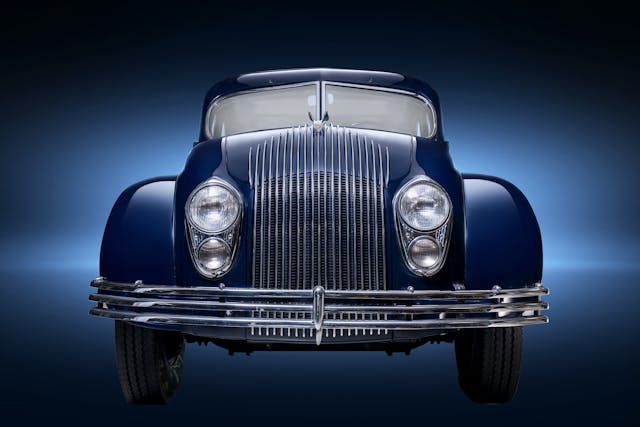Media | Articles
1934 Chrysler Airflow: The car of the future that arrived a little too early
The first one in Oregon rolled into Medford behind a state police escort. A Mrs. George Brown of Honolulu complained of being harassed by onlookers wherever she parked hers downtown. Babe Ruth had one, as did actor Dick Powell. Indy veteran Harry Hartz set 72 speed and distance records at the Bonneville Salt Flats in one, driving 97.5 mph over the flying mile. Then he drove from New York to San Francisco in the same car, averaging 18 mpg and spending just $33.06 on gas. “We had the horse and buggy,” enthused Walter P. Chrysler. “We had the automobile. Now we have the first real motor car in history.”
The Chrysler Airflow—it was also called the Airflow Chrysler, the Airflow Imperial, and the DeSoto Airflow—was a lightning flash of innovation in the midst of the wretched Great Depression. Its debut at the New York auto show on Saturday, January 6, 1934, made the newspapers around the nation, and its advancements in engineering and design foreshadowed almost every mass-produced car that followed, including the cars we drive today. The Airflow was also a flop, soundly rejected by the buying public for the four short years of its existence. Chrysler yanked it in defeat after the 1937 model year and turned its back on design flair for a generation. Though the auto industry’s dustbin is full of pioneers that were doomed to be unappreciated in their moment, the Airflow is one of its most illustrious residents.
What a thrilling place to work the newly formed Chrysler Corporation must have been in its earliest days. The auto industry of the 1920s resembled freewheeling Silicon Valley in the 1990s. A constant gyre of talent and ideas and investor cash saw companies rise and fall and merge and die seemingly overnight. In 1922, the gregarious Walter P. Chrysler ran out of the house fire that was Willys-Overland and, after a few false starts, in 1925 incorporated Chrysler atop the bones of the ailing Maxwell Motor Company. He immediately hired his so-called “Three Musketeers,” ex-Studebaker and Willys-Overland engineers Carl Breer, Owen Skelton, and Fred Zeder. Breer and Zeder had known each other since their apprenticeship days, and they met Skelton while at Studebaker. The trio instantly meshed as a unit; Zeder was the salesman, Skelton was a disciplined powertrain expert, and Breer was the dreamer, the guy who had the kind of crazy schemes that Walter P. Chrysler loved.
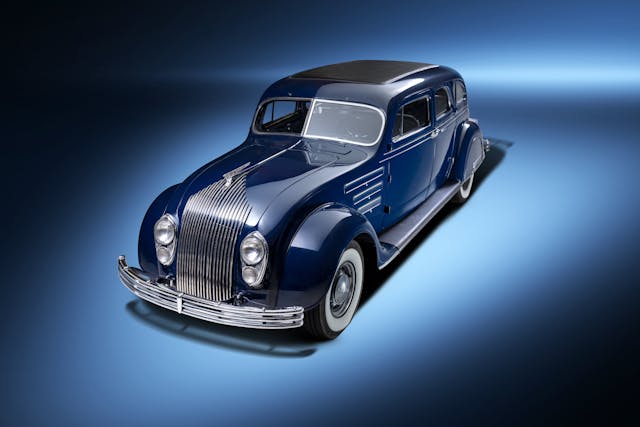
Breer’s mind was churning. He was preoccupied with the rising speeds of the increasingly more powerful cars that were coming out—and with gazing skyward one day in 1927 at a formation of Army planes circling over his summer house at Gratiot Beach on Lake Huron north of Detroit. It’s no cosmic coincidence that the automobile and powered flight were invented at nearly the same moment; both were a byproduct of advances in internal combustion. But no automaker had attempted to fuse the two forms of transportation in any meaningful way.
Breer’s first step was to study how air flowed around a car, so he built the auto industry’s first wind tunnel. It was a compact unit not even 2 feet wide by 3 feet tall, driven by a 35-hp DC electric motor connected to fans with a V-belt. Models made in the adjacent wood shop were placed against plates coated with linseed oil and lampblack, or the carbon soot left over from burning lamp oil.
Marketplace
Buy and sell classics with confidence
The engineers watched as the air flowing around the models drew traces through the soot. “One startling result of our investigation,” Breer wrote, “was the realization that our cars were so poorly designed from an air resistant point of view that they would actually run faster backwards than forward.”
They discovered that a bluff front end along with the elimination of valleys between the fenders and the body and “a smooth sweeping contour from the windshield back to the rear end of the car” was more conducive to clean flow than the upright grilles, long hoods, cycle fenders, and setback cockpits of most mid-1920s cars. Day after day, models went in and out of the tunnel, and a shape resembling that of a zeppelin developed as the ideal. Breer and his team began to imagine a car in which, as with a zeppelin, the mass of the body was moved forward to punch a clean hole through air that would then flow smoothly along the car’s side and off its tapered tail. But to execute the vision, the company would need an entirely new kind of automobile.
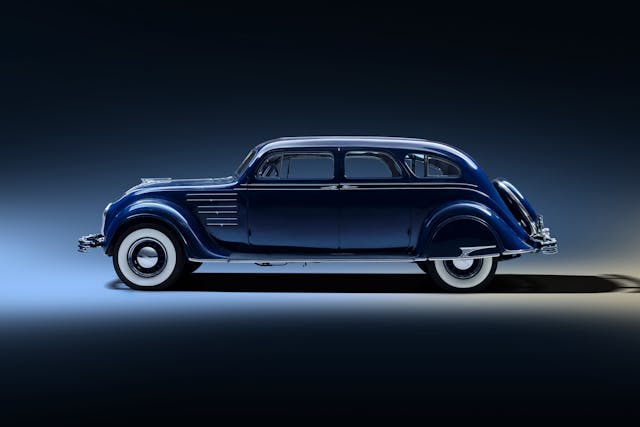
In those days of solid axles supported by transverse leaf springs and long, inline engines (more compact V-shaped engines were still a few years away), the engine sat entirely behind the front axle. That pushed the flat-roofed cabin, riding high atop the ladder frame, aft over the rear axle. The whole car sat on its haunches. And if the designer was to impart any visual sleekness at all—an increasing imperative in the go-go 1920s—the interior would necessarily be cramped in every dimension, having as it did to make allowances for the engine in front and the frame underneath. The rear-seat passengers got the shortest end of the stick, sitting directly above the rear axle and being pounded with each bump.
To make the shape he wanted, Breer would have to ditch the traditional ladder frame so that the engine and passengers, rather than riding above the frame, would ride within it. He envisioned a body in which the loads were carried by “bridge trusses” spanning the perimeter of the cabin, the entire body a cage providing the structural support that the ladder frame did in existing cars. Further, after studying and rejecting a rear-mounted engine, the team moved the engine forward between front wheels that were each supported by independent, coil-sprung suspension arms. Then the engineers pushed the entire cabin 20 inches forward so that its occupants would now be suspended between the axles. Thus, the ride comfort would improve greatly over contemporary cars, and there would be enough headroom for the rear passengers even as the roof sloped down toward the back. Despite a design beholden to a 1920s understanding of aerodynamics as rendered in soot and linseed oil, the package promised more interior space and better ride comfort (if rather compromised visibility) than anything marketed at the time.
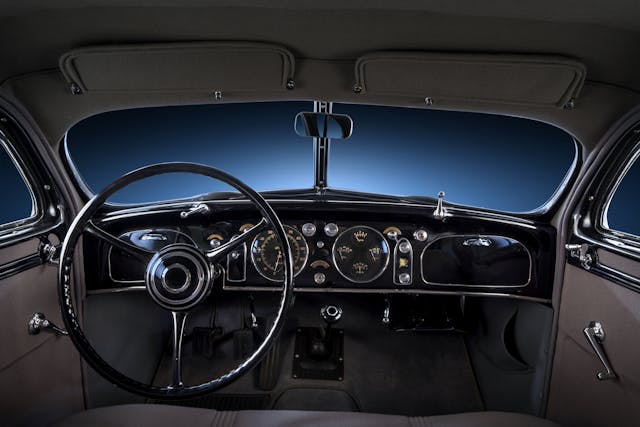
Perhaps unaware of exactly how prescient they were, Walter P. and his Three Musketeers invented the modern unibody vehicle, for the above description fits just about every passenger car made in the past 40 years. However, the first full-scale aerodynamic test vehicle in 1929 resembled a snub-nosed pig being swallowed by a giant wasp, and it was obvious to everyone that it was too much. Still, Walter P. was entirely sold on the project, and development continued through the Black Tuesday stock market crash in October of that year and on into the gathering gloom of the Great Depression.
Breer’s team built the first running Airflow prototype in September 1932. By then, 14 million people had been thrown out of work and were standing in bread lines with their “Hoover flags flying,” as folks took to calling their turned-out pants pockets. Nearly one in every three wage earners in the U.S. was unemployed. When the city of Birmingham, Alabama, advertised for 750 laborers to do “the hard, dirty work of digging” a canal for $2 per 10-hour day, more than 12,000 people showed up.
Amid that backdrop, the Trifon Special was born incorporating many of the features that would appear later on the production Airflow, including the unitized body with concealed running boards, a one-piece curved windshield, and a built-in trunk accessible through the rear passenger seats. The existence of the hand-fabricated prototype was so secret that the company registered it in the name of one of its test drivers, Demitrion Trifon, without the name Chrysler appearing in any of its paperwork. When Walter P. drove up to the farm near West Branch, Michigan, where the first road tests of the Trifon were being conducted, he took a competitor’s car so as not to arouse suspicion.
Chrysler was so smitten that he greatly expanded the plans for production, which originally had the Airflow model going solely to the company’s midpriced DeSoto division. Instead, there would be Chrysler, DeSoto, and Imperial versions of the Airflow. There would be four body styles, including a sedan, brougham, limo, and coupe, riding on four separate wheelbases. Two straight-eight engines would be offered in the Chryslers and Imperials ranging from 122 to 145 horsepower, the Imperial’s aluminum cylinder head claiming the highest standard compression ratio (6.5 to 1) of any production car then sold. DeSotos got an inline-six.
For the time, the list of technical innovations was impressive and showed the influence of Owen Skelton’s powertrain expertise. A vacuum-operated automatic clutch, a push-button overdrive, and Lockheed vacuum-assisted hydraulic brakes were all options. Even the Airflow’s front seat was unusual. It looked like a davenport sofa cradled in chrome-plated steel tubes that provided firm handrails. Producing them proved a complicated business, employing an entirely new department at the plant with a crew of 150. The Airflow would slice through the Depression as well as the wind.
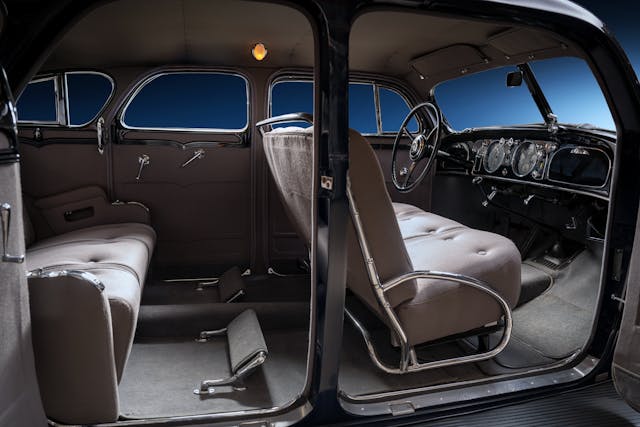
Having raised the stakes, Chrysler put its complex creation into halting, delayed production for the 1934 model year at its Jefferson Avenue plant in Detroit, with the bodies hand-welded and finished at the company’s adjacent Kercheval Body Plant. Newspapers heralded the Airflow with wall-to-wall coverage, noting its technical advances and arresting new shape. It was said the car could cruise comfortably at 70 mph, that the new type of chassis was so stiff and the suspension so supple that it provided a “floating ride” with no vibration at all. It was so aerodynamic, it was reported, that raindrops and insects were lofted by the wind currents up and over the car without ever touching it. The papers said that streamlining was in its infancy but destined to be copied by others—and other forms of transportation. That much, at least, was true.

Dealers wallpapered their local broadsheets with ads, many featuring testimonials from neighborhood buyers such as David L. Barsaloux of 7406 Oglesby Ave., Chicago (the times were so innocent that people’s addresses were routinely printed in the paper), who supposedly told his South Chicago dealer, “It’s the greatest car I ever drove!” It was largely for naught, however, as buyers were cold to the car’s startling shape and especially its face, with its giant waterfall grille bracketed by droopy, basset-hound eyes. Moreover, all the innovations had come at a price; the cheapest Airflow, the DeSoto sedan at $995, was $120 more than the comparable ’33 model. This at a time when mass starvation and communist revolution were serious concerns to the new Roosevelt administration. DeSoto’s sales took a 46 percent hit in 1934.
Chrysler embarked on a futile three-year odyssey to save the Airflow. It redesigned the front end for ’35, raising the grille more upright and fitting a one-piece bumper, all of which gave the car a more traditional prow and a longer side-profile silhouette. It also pared the body choices and introduced a more conventional as well as cheaper car called the Airstream. In ’36, it face-lifted the Airflow again and tossed the elaborate seat tubing, but sales of most configurations were only in the hundreds. By 1937, the DeSoto version was gone, and only one Chrysler model remained to close out the sputtering experiment.
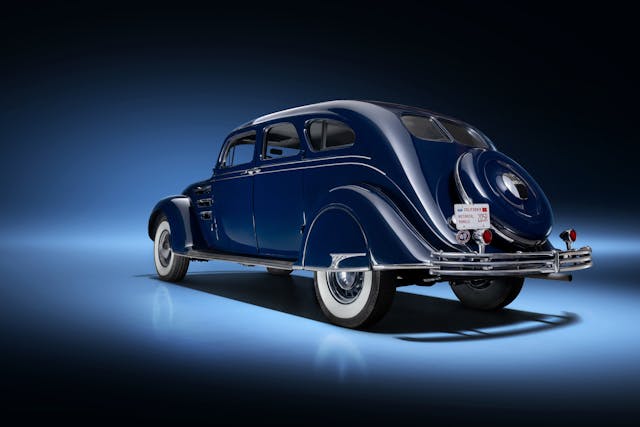
“The car was too far ahead of its time,” concluded Breer years later. Though it was a market failure, the Airflow was enormously influential. By the late 1930s, most car companies had incorporated some elements of the design, if not the unitized chassis construction that would later become nearly universal. The 1936 Lincoln Zephyr was a virtual crib of the Airflow, and after the Japanese royal household took delivery of a new Airflow in 1934, Toyota’s very first car, the 1936 AA, bore more than a passing resemblance.
The effect on Chrysler, however, was to chill styling innovation for two decades. When Virgil Exner joined the company’s design staff in 1953, it was frozen in conservative paralysis, the management obsessed with interior headroom and exterior conventionality. Sales were ebbing. Like Macbeth trembling before Banquo’s ghost, Chrysler was being haunted into near bankruptcy by the specter of the Airflow. It took Exner a few years to persuade his bosses to once again swing for the fences with the long and low Forward Look cars of 1957.
“Timing is everything,” Exner said as his rocket-age tail fins were pushing Chrysler’s sales toward a postwar high. “You can be just as wrong by being too soon with an idea as being too late.” Indeed, the Airflow had already proved this to be true.
1934 Chrysler Airflow Imperial
Engine: I-8, 324 cid
Power: 130 hp @ 3400 rpm
Transmission: 3-speed
Weight: 4300 lb
Power-to-Weight: 33.1 lb/hp
Brakes: Vacuum-assisted drum
Price when new: $2345
Hagerty #2 value: $110,000–$150,000
